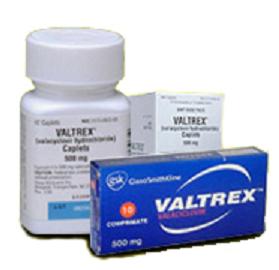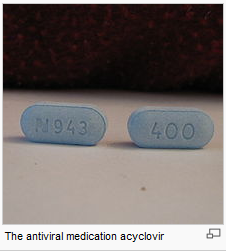Herpes simplex - wikipedia part 2
Source:
http://en.wikipedia.org/wiki/Herpes_simplex
Diagnosis
Primary orofacial herpes is readily identified by clinical examination of persons with no previous history of lesions and contact with an individual with known HSV-1 infection. The appearance and distribution of sores in these individuals typically presents as multiple, round, superficial oral ulcers, accompanied by acute gingivitis. Adults with non-typical presentation are more difficult to diagnose. Prodromal symptoms that occur before the appearance of herpetic lesions help differentiate HSV symptoms from the similar symptoms of other disorders, such as allergic stomatitis. When lesions do not appear inside the mouth, primary orofacial herpes is sometimes mistaken for impetigo, a bacterial infection. Common mouth ulcers (aphthous ulcer) also resemble intraoral herpes, but do not present a vesicular stage.
Genital herpes can be more difficult to diagnose than oral herpes since most HSV-2-infected persons have no classical symptoms. Further confusing diagnosis, several other conditions resemble genital herpes, including fungal infection, lichen planus, atopic dermatitis, and urethritis. Laboratory testing is often used to confirm a diagnosis of genital herpes. Laboratory tests include: culture of the virus, direct fluorescent antibody (DFA) studies to detect virus, skin biopsy, and polymerase chain reaction (PCR) to test for presence of viral DNA. Although these procedures produce highly sensitive and specific diagnoses, their high costs and time constraints discourage their regular use in clinical practice.
Until recently, serological tests for antibodies to HSV were rarely useful to diagnosis and not routinely used in clinical practice. The older IgM serologic assay could not differentiate between antibodies generated in response to HSV-1 or HSV-2 infection. However, the new Immunodot glycoprotein G-specific (IgG) HSV test is more than 98% specific at discriminating HSV-1 from HSV-2. It is the opinion of some modern medical professionals that the new IgG test should always be clinically preferred to the old IgM test, however not all doctors appear to be informed of the availability of the newer, reliable IgG tests.
Barrier methods
Condoms offer moderate protection against HSV-2 in both men and women, with consistent condom users having a 30% lower risk of HSV-2 acquisition compared with those who never use condoms The virus cannot pass through a latex condom, but a condom's effectiveness is limited because[citation needed] it does not prevent skin contact or bodily fluid contact with the scrotum, anus, buttocks, upper thighs or area immediately surrounding the penis, all of which are susceptible to infection with and transmission of the virus. Preventing contact with these areas during sex, in addition to wearing a condom, should theoretically provide enhanced protection against herpes.[original research?] The use of condoms or dental dams also limits the transmission of herpes from the genitals of one partner to the mouth of the other (or vice versa) during oral sex. When one partner has a herpes simplex infection and the other does not, the use of antiviral medication, such as valaciclovir, in conjunction with a condom, further decreases the chances of transmission to the uninfected partner. Topical microbicides which contain chemicals that directly inactivate the virus and block viral entry are being investigated.
Vaccine
Vaccines for HSV are undergoing trials. Once developed, they may be used to help with prevention or minimize initial infections as well as treatment for existing infections
Antivirals
Antivirals may reduce asymptomatic shedding; it is believed asymptomatic genital HSV-2 viral shedding occurs on 20% of days per year in patients not undergoing antiviral treatment, versus 10% of days while on antiviral therapy
Pregnancy
The risk of transmission from mother to baby is highest if the mother becomes infected at around the time of delivery (30% to 60%), but the risk falls to 3% if it is a recurrent infection, and is less than 1% if there are no visible lesions. To prevent neonatal infections, seronegative women are recommended to avoid unprotected oral-genital contact with an HSV-1 seropositive partner and conventional sex with a partner having a genital infection during the last trimester of pregnancy. A seronegative mother who contracts HSV at this time has up to a 57% chance of conveying the infection to her baby during childbirth, since insufficient time will have occurred for the generation and transfer of protective maternal antibodies before the birth of the child, whereas a woman seropositive for both HSV-1 and HSV-2 has around a 1-3% chance of transmitting infection to her infant. Women who are seropositive for only one type of HSV are only half as likely to transmit HSV as infected seronegative mothers. Mothers infected with HSV are advised to avoid procedures that would cause trauma to the infant during birth (e.g. fetal scalp electrodes, forceps, and vacuum extractors) and, should lesions be present, to elect caesarean section to reduce exposure of the child to infected secretions in the birth canal. The use of antiviral treatments, such as acyclovir, given from the 36th week of pregnancy, limits HSV recurrence and shedding during childbirth, thereby reducing the need for caesarean section.
Acyclovir is the recommended antiviral for herpes suppressive therapy during the last months of pregnancy. The use of valaciclovir and famciclovir, while potentially improving compliance have less well determined safety in pregnancy.
Treatment
There is no method to eradicate herpes virus from the body, but antiviral medications can reduce the frequency, duration, and severity of outbreaks. Analgesics such as ibuprofen and acetaminophen can reduce pain and fever. Topical anesthetic treatments such as prilocaine, lidocaine, benzocaine or tetracaine can also relieve itching and pain
Antiviral
There are several antivirals that are effective for treating herpes including: aciclovir (acyclovir), valaciclovir (valacyclovir), famciclovir, and penciclovir. Aciclovir was the first discovered and is now available in generic.
Evidence supports the use of aciclovir and valaciclovir in the treatment of herpes labialis. as well as herpes infections in people with cancer. The evidence to support the use of acyclovir in primary herpetic gingivostomatitis is less strong.
Topical
A number of topical antivirals are effective for herpes labialis including acyclovir, penciclovir, and docosanol. Docosanol can be purchased over the counter in Canada and the USA.
Alternative medicine
Certain dietary supplements and alternative remedies are claimed to be beneficial in the treatment of herpes. There is however insufficient evidence to support use of many of these compounds including echinacea, eleuthero, L-lysine, zinc, bee products and aloe vera.
A single study indicates possible benefit from laser treatment.

